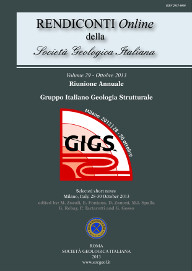
Jurassic paleogeographic reconstruction and Cenozoic tectonic evolution of the Lucretili and Sabini Mountains (central Italy), new data and interpretations
Giacomo Medici (a) & Dario Saccoccia (b)
(a) School of Earth and Environment, University of Leeds, Leeds LS2 9 JT, UK.
(b) Via di Villa Braschi 15, Tivoli (RM); saccoccia.dario@gmail.com
DOI: https://doi.org/
Volume: 29/2013
Pages: 101-103
Abstract
The study area is located in the central Apennines (Italy), between the Lucretili and the southern Sabini Mountains.
The stratigraphic and structural data collected in the field resulted in a paleogeographic reconstruction of the Sabina domain that is comparable with the paleogeography of the Umbria-Marche domain, in which the Jurassic horsts are spaced by a distance of about ten kilometers.
The structural analysis of fault planes allowed to reconstruct the Tertiary tectonic evolution of the sector, which was affected by five kinematic phases. A first compressional phase, with NE-SW maximum compression, was followed by a second compressional phase with WNWESE maximum compression.
The polyphasic compressional phase affected this sector during the late Miocene-early Pliocene, it is due to the convergence between the African plate and the European plate.
The compression was followed by a minor strike-slip tectonic phase. Compressional and strike slip structures were then affected by an extensional phase, subsequent to the early Pliocene, with NE-SW minimum compression.
The extensional phase is due to the roll-back of the Adria slab.
Finally a new Pleistocene strike-slip phase affected the study area and it can be related to the stress due to the effect of the Mesozoic rifting on the lithosphere, in terms of subductibility.
Keywords
Get Full Text